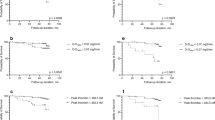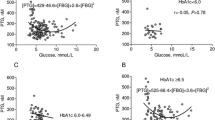Abstract
Objective
Previous studies showed a significant association between lower plasma adiponectin levels and higher risk of adverse cardiovascular outcomes in patients with and without type 2 diabetes mellitus (T2DM). Presently, it is uncertain whether lower plasma adiponectin levels are associated with greater plasma thrombin generation in patients with T2DM.
Patients and methods
We studied 82 middle-aged men with non-insulin-treated T2DM [mean age ± SD: 64.1 ± 8 years; median duration of diabetes: 12.5 (inter-quartile range 6–19) years; mean hemoglobin A1c 7.0 ± 0.7%], consecutively attending our diabetes outpatient service over a 6-month period. Using the newly developed fully automated thrombin generation analyzer ST Genesia®, we measured the plasma parameters lag time (LT), time to peak (TP), peak height (PH) and endogenous thrombin potential (ETP) in all participants.
Results
In univariable linear regression analyses, lower plasma adiponectin levels were significantly associated with higher plasma thrombin generation parameters, as reflected by higher values of PH (Pearson’s r coefficient = − 0.228, p = 0.039) and EPT (r = − 0.293, p = 0.007). Plasma adiponectin levels were not significantly associated with other thrombin generation parameters (LT and TP). Notably, the significant associations of plasma adiponectin levels with thrombin PH and EPT values persisted after adjustment for age and adiposity measures, but they were lost after additional adjustment for plasma triglycerides.
Conclusion
Our findings show for the first time the existence of a significant association between lower levels of plasma adiponectin and greater plasma thrombin generation (as assessed by the ST Genesia® analyzer) in men with non-insulin-treated T2DM, which appears to be largely mediated by plasma triglycerides.


Similar content being viewed by others
References
Scherer PE, Williams S, Fogliano M, Baldini G, Lodish HF (1995) A novel serum protein similar to c1q, produced exclusively in adipocytes. J Biol Chem 270:26746–26749
Achari AE, Jain SK (2017) Adiponectin, a therapeutic target for obesity, diabetes, and endothelial dysfunction. Int J Mol Sci 18(6):1321. https://doi.org/10.3390/ijms18061321
Whitehead JP, Richards AA, Hickman IJ, Macdonald GA, Prins JB (2006) Adiponectin-a key adipokine in the metabolic syndrome. Diabetes Obes Metab 8:264–280
Targher G, Bertolini L, Rodella S, Zoppini G, Scala L, Zenari L, Falezza G (2006) Associations between plasma adiponectin concentrations and liver histology in patients with nonalcoholic fatty liver disease. Clin Endocrinol (Oxf) 64:679–683
Ebrahimi-Mamaeghani M, Mohammadi S, Arefhosseini SR, Fallah P, Bazi Z (2015) Adiponectin as a potential biomarker of vascular disease. Vasc Health Risk Manag 11:55–70
Kumada M, Kihara S, Sumitsuji S, Kawamoto T, Matsumoto S, Ouchi N, Arita Y, Okamoto Y, Shimomura I, Hiraoka H, Nakamura T, Funahashi T, Matsuzawa Y, Osaka CAD Study Group (2003) Association of hypoadiponectinemia with coronary artery disease in men. Arterioscler Thromb Vasc Biol 23:85–89
Frystyk J, Berne C, Berglund L, Jensevik K, Flyvbjerg A, Zethelius B (2007) Serum adiponectin is a predictor of coronary heart disease: a population-based 10-year follow-up study in elderly men. J Clin Endocrinol Metab 92:571–576
Hashimoto N, Kanda J, Nakamura T, Horie A, Kurosawa H, Hashimoto T, Sato K, Kushida S, Suzuki M, Yano S, Iwai R, Takahashi H, Yoshida S (2006) Association of hypoadiponectinemia in men with early onset of coronary heart disease and multiple coronary artery stenoses. Metabolism 55:1653–1657
Pischon T, Girman CJ, Hotamisligil GS, Rifai N, Hu FB, Rimm EB (2004) Plasma adiponectin levels and risk of myocardial infarction in men. JAMA 291:1730–1737
Yang L, Li B, Zhao Y, Zhang Z (2019) Prognostic value of adiponectin level in patients with coronary artery disease: a systematic review and meta-analysis. Lipids Health Dis 18:227
Kalz J, ten Cate H, Spronk HM (2014) Thrombin generation and atherosclerosis. J Thromb Thrombolysis 37:45–55
Loeffen R, Spronk HM, ten Cate H (2012) The impact of blood coagulability on atherosclerosis and cardiovascular disease. J Thromb Haemost 10:1207–1216
Salvagno GL, Favaloro EJ, Demonte D, Gelati M, Poli G, Targher G, Lippi G (2019) Influence of hypertriglyceridemia, hyperbilirubinemia and hemolysis on thrombin generation in human plasma. Clin Chem Lab Med 57:1784–1789
Tripodi A (2016) Thrombin generation assay and its application in the clinical laboratory. Clin Chem 62:699–707
Hemker HC, Giesen P, Al Dieri R, Regnault V, de Smedt E, Wagenvoord R, Lecompte T, Béguin S (2003) Calibrated automated thrombin generation measurement in clotting plasma. Pathophysiol Haemost Thromb 33:4–15
Mantovani A, Turino T, Lando MG, Gjini K, Byrne CD, Zusi C, Ravaioli F, Colecchia A, Maffeis C, Salvagno G, Lippi G, Bonora E, Targher G (2019) Screening for non-alcoholic fatty liver disease using liver stiffness measurement and its association with chronic kidney disease and cardiovascular complications in patients with type 2 diabetes. Diabetes Metab. https://doi.org/10.1016/j.diabet.2019.11.004
Levey AS, Stevens LA, Schmid CH, Zhang YL, Castro AF 3rd, Feldman HI, Kusek JW, Eggers P, Van Lente F, Greene T, Coresh J, CKD-EPI (Chronic Kidney Disease Epidemiology Collaboration) (2009) A new equation to estimate glomerular filtration rate. Ann Intern Med 150:604–612
American Diabetes Association (2019) Microvascular complications and foot care: standards of medical care in diabetes-2019. Diabetes Care 42(suppl 1):S124–S138
Chitongo PB, Roberts LN, Yang L, Patel RK, Lyall R, Luxton R, Aylwin SJB, Arya R (2017) Visceral adiposity is an independent determinant of hypercoagulability as measured by thrombin generation in morbid obesity. TH Open 1:e146–e154
Pischon T, Hu FB, Girman CJ, Rifai N, Manson JE, Rexrode KM, Rimm EB (2011) Plasma total and high molecular weight adiponectin levels and risk of coronary heart disease in women. Atherosclerosis 219:322–329
Yanai H, Yoshida H (2019) beneficial effects of adiponectin on glucose and lipid metabolism and atherosclerotic progression: mechanisms and perspectives. Int J Mol Sci 20:1190
Christou GA, Kiortsis DN (2013) Adiponectin and lipoprotein metabolism. Obes Rev 14:939–949
Restituto P, Colina I, Varo JJ, Varo N (2010) Adiponectin diminishes platelet aggregation and sCD40L release. Potential role in the metabolic syndrome. Am J Physiol Endocrinol Metab 298:E1072–1077
Chen Y, Zheng Y, Liu L, Lin C, Liao C, Xin L, Zhong S, Cheng Q, Zhang L (2017) Adiponectin inhibits TNF-α-activated PAI-1 expression via the cAMP-PKA-AMPK-NF-κB axis in human umbilical vein endothelial cells. Cell Physiol Biochem 42:2342–2352
Reiner Ž (2017) Hypertriglyceridaemia and risk of coronary artery disease. Nat Rev Cardiol 14:401–411
Nordestgaard BG, Varbo A (2014) Triglycerides and cardiovascular disease. Lancet 384:626–635
Mach F, Baigent C, Catapano AL, Koskinas KC, Casula M, Badimon L, Chapman MJ, De Backer GG, Delgado V, Ference BA, Graham IM, Halliday A, Landmesser U, Mihaylova B, Pedersen TR, Riccardi G, Richter DJ, Sabatine MS, Taskinen MR, Tokgozoglu L, Wiklund O, ESC Scientific Document Group (2020) 2019 ESC/EAS Guidelines for the management of dyslipidaemias: lipid modification to reduce cardiovascular risk. Eur Heart J 41:111–188
Targher G, Zoppini G, Moghetti P, Day CP (2010) Disorders of coagulation and hemostasis in abdominal obesity: emerging role of fatty liver. Semin Thromb Hemost 36:41–48
Franchini M, Lippi G, Manzato F, Vescovi PP, Targher G (2010) Hemostatic abnormalities in endocrine and metabolic disorders. Eur J Endocrinol 162:439–451
Mi Y, Yan S, Lu Y, Liang Y, Li C (2016) Venous thromboembolism has the same risk factors as atherosclerosis: a PRISMA-compliant systemic review and meta-analysis. Medicine (Baltimore) 95:e4495
Funding
GT is supported in part by Grants from the University School of Medicine of Verona, Verona, Italy.
Author information
Authors and Affiliations
Contributions
Study concept and design: GL and GT. Acquisition of data: AM, ED, GLS, and MGTT. Analysis and interpretation of data: AM and GT. Drafting of the manuscript: GT and GL. Critical revision of the manuscript for important intellectual contents: all authors study supervision: GT. All authors approved the final submission.
Corresponding author
Ethics declarations
Conflict of interest
The authors have nothing to disclose.
Ethical approval
The study was approved by the University and Azienda Ospedaliera Universitaria Integrata of Verona. All procedures performed in human participants were in accordance with ethical standards of the institutional/national research committee and 1964 Helsinki Declaration and its later amendments.
Informed consent
Informed consent was obtained from all participants.
Additional information
Publisher's Note
Springer Nature remains neutral with regard to jurisdictional claims in published maps and institutional affiliations.
Rights and permissions
About this article
Cite this article
Mantovani, A., Danese, E., Salvagno, G.L. et al. Association between lower plasma adiponectin levels and higher plasma thrombin generation parameters in men with type 2 diabetes: role of plasma triglycerides. J Endocrinol Invest 44, 547–555 (2021). https://doi.org/10.1007/s40618-020-01340-3
Received:
Accepted:
Published:
Issue Date:
DOI: https://doi.org/10.1007/s40618-020-01340-3




